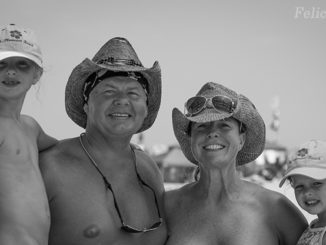The Complete History of Nudism, Nudists and Nudity
In this article will explore both nudism and nudity throughout history. While organized nudism, as a movement, is considerably young, social nudity is as old as Adam and Eve.
Nudism and Nudists History Part One – Nudity in the Bible
Nudity In The Bible – When the word nude or naked is mentioned, the first thought is of Adam and Eve. The Biblical Book of Genesis states at the end of Chapter 2 in verse 25 that the man and his wife were both naked, and they felt no shame. In Chapter 3, after Adam and Eve eat of the fruit of the tree, they become aware of their nakedness and cover themselves in shame. Because nudism exists today in a cultural, social and political context, Adam and Eve would not be considered true social nudists.
Only two people existed in the world. Therefore, there was no true society, or culture or political arena. There are, however, Christian nudists who believe that Adam and Eve covering their bodies in shame was the true sin. God made the human body and God never created anything evil or ugly.
In addition, throughout the Bible there are references to prophetic nudity, such as Saul laying nude to have a vision and joyful nudity such as King David dancing naked for joy when the Ark of the Covenant arrived in Jerusalem.
However, these were various incidents and not a culture as a whole practicing nudism. The true origins of “social nudism / nudity” would have to be traced to the Ancient Egypt and to the Greek and Roman Empires. It was in those societies that the first forms of social nudity as cultural, social, and political foundations were laid.
Nudity has played an important part of the world’s development and has evolved and flowed along many political and social climates, from the origins in Greece to Victorian England, to the Renaissance period experienced in both Europe and America into the twentieth and twenty-first centuries.
Nudity in Ancient Egypt
Tablets from Ancient Egypt were discovered that proved Pharaoh Akhen-Aton (1385 – 1353 B.C.) and his wife Nefertiti, considered the sun to be the wellspring of life. So it was natural that they enjoyed nakedness and sunbathing for both physical health and spiritual reasons.
Victorian archaeologists who discovered the tablets and wall carvings were critical as they discovered that the Pharaoh and his wife, along with the Egyptian court, practiced social nudity not only in the swimming pools, but also in the royal gardens and palace.
While ancient Egyptians embraced nudity, Jews of the time viewed nakedness as culturally embarrassing. Most captive Jews were forced to be naked and were often whipped upon the bare buttocks. Those Jews who fought in the gladiator arenas often covered their glans with sheep or ram gut to conceal the fact that they were circumcised as this was particular to their race. Otherwise, they were often laughed at and looked upon with derision.
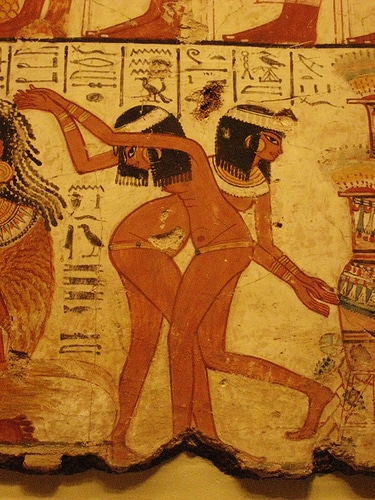
Social Nudity In Ancient Greece and Rome
Centuries after Pharaoh Akhen-Aton’s reign, Greek culture began a movement towards holistic living. The Greek culture of that time considered the human body to be aesthetically pleasing and a work of beauty. In Greek culture, depictions of the naked human body were not only normal, but beautiful. This was not in terms of eroticism, but rather because they appreciated the arts and nature.
The Greeks were known for their athleticism and training in gymnasiums, which when literally translated, means a place to train naked. In ancient Rome and in ancient Greece, public nudity was acceptable not only in the sports arena, but also in terms of public bathing. The dress style of both the ancient Greek and Roman cultures allowed for easy disrobing. The draped clothing could be taken off with just the simple release of the shoulder clips.
The gymnasiums themselves were not merely venues for exercise, but were also forums where music, philosophy, and general education were taught. The worship of the Greek and Roman gods meant that these cultures tried to not only please their gods, but to also imitate them. There could be no greater worship, by their beliefs, than to develop their bodies both mentally and physically to the best of their abilities.
The major schools of philosophy, music, and art were all housed in gymnasiums. Even as religion began to decline and be replaced by philosophy, nudity as a social, cultural and political movement was still popular. Socrates advocated nudity as a form of honesty.
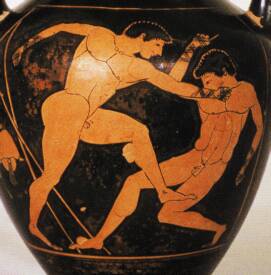
Nudity and the Olympic Games
The Olympic Games featured a tradition of nudity. Historians believe that the Olympic Games began around 1100 B.C. as peace contests among the kings of the various Greek cities such as Pisa and Sparta. By 776 B.C., the Olympic Games had become an homage to the Greek gods. Historians believe that the Spartans were the first to remove their clothing during training and competition.
The nude Spartans won the majority of the games and events. The rest of Greek society noticed that the Spartans were able to win because they were not hampered and weighed down by clothing. Nudity remained an important part of not only the Olympic Games, but also the various other Panhellenic Games. It is thought that nudity gave athletes a competitive edge, while also allowing the judges to ensure there was no cheating. Evidence, in the form of works of art and statues, such as the work Milo of Croton, exists today proving that the Greeks honored nudity and athleticism. The Olympics continued on in this way and Greek and Roman culture became widely known and regarded throughout the years.
In 393 A.D., Christian Roman Emperor Theodosium believed the Olympic Games to be pagan rituals and had them banned. This led to the athletes and philosophers and the gymnasium itself, to be treated with disdain. The gladiator games, which had also been fought in the nude, were abandoned along with the Olympic Games. The view by Christians that nudity was a sin became the norm and began to spread through Europe.
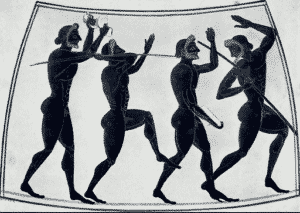
Nudity in Ancient India
At the same time that Greece and Rome were experiencing their freedom from clothing and celebrating the mind and body, ancient holy men from India were also experiencing the trend of gymnos, the act of being naked, and had several sects of gymnosophists, or nude philosophers. Alexander the Great was so impressed by the reports of these men, that he sent his own philosophers to India to meet and exchange ideas.
Later Alexander himself traveled to India and met with these philosophers and holy men, impressed as he was by the reports from his Greek traveling philosophers. This led to many cultural interchanges between the two countries. There were a large number of ascetic sects in India who lived and practiced their beliefs in the nude during this time period.
Buddha was a nude ascetic prior to founding his own religion. It has been mused that perhaps Buddha and his followers began wearing robes merely to distinguish themselves from other sects. There are still naked holy men in India today, most associated with the holy sect of the Jains, an ancient Indian religion that was formed back around 500 B.C.
Unlike the Greek and Romans however, the Jains did not practice nudity as an expression of freedom and appreciation for the human body, art and nature. Rather, the Jains practiced nudity as a form of piety by giving up all their worldly goods, clothing included.
It is thought by historians and scholars that while the Greeks focused primarily on the emphasis of beauty, knowledge and fun, the gymnosophists of India referred to their nudity as a method of gaining spiritual enlightenment and becoming one with the universe. The tie that seemed to bind the two cultures together was the idea of peace that both the Olympic Games and the Jains religion practiced.
Just as the Christian control of Greece and Rome led to the ending of the gymnasium and the Olympic Games, the British control of India led to the curtailing of gymnosophist practices.
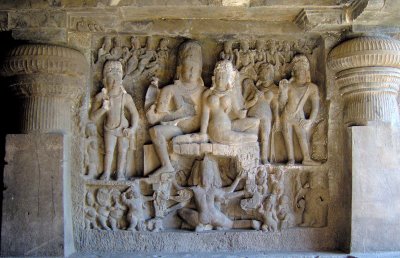
Nudity in East Asia
Unlike India, Greece and Rome, East Asia had entirely different views on nudity and the practice of social nakedness. Until recently, the Japanese participated in nude communal bathing, and some smaller rural areas still practice this tradition today.
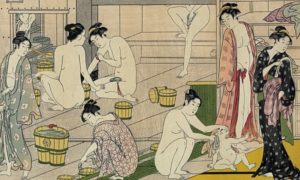
While ancient Japanese art has no nudity depicted in it, this is not because they viewed nudity as a sin. The Japanese simply enjoyed becoming tangled in each other’s clothing when becoming intimate.
Communal nude bathing by the Japanese, which began as a Shinto purification rite, became the standard and the norm. In addition, Japan has numerous hot springs which led to nude family and mixed bathing being approved by the various religions for over two thousand years.
Members of the Chinese race had entirely different views on nudity. The upper class believed nudity to be something that only peasants would practice. Their art reflects no nudity because they believed it to be highly immoral. The Chinese views of nakedness as a sin extended as far as to consider the paintings of the Christian saints to be immoral because they were depicted in loose, flowing robes.
The Chinese upper class woman could not even disrobe in front of her doctor. Each upper class Chinese woman carried a tiny statue made of either alabaster or ivory and used the statue to point to the area of the body that was giving her a problem.
Nudity During The Middle Ages
After the abandonment of the Olympics and the fall of the Roman Empire, the Christian Reformation spread throughout Europe and nudity came to be regarded as sinful. This was the time period known as the Middle Ages, which was not defined by one single view of nudity, but rather saw public opinion change as time went on.
In the beginning of the Middle Ages, society was dominated by priests who had restrictive views towards the nude body, women and sexuality. It was to no avail for people to try to explain that nakedness had nothing to do with eroticism or sexuality. This view held for quite awhile.
Then, halfway through the Middle Ages, attitudes towards nudity became more open. This was the time of the Renaissance, when troubadours, chivalry, and an admiration for women and art became noted. Nude art and statues were not merely limited to religious themes, but began celebrating the naked human form. There seems to be a direct correlation between the artistic movement burgeoning and the freedom of body movement experienced by those living in this age.
Granted, social and / or public nudity was not practiced to the same extent as it was in Greco-Roman times, however, the human body was no longer something of which to be ashamed. These attitudes and feelings prevailed until the 16th Century and the rise of John Calvin and Martin Luther.

Nudity During The Reformation
John Calvin was a Frenchman who became the founder of the Presbyterian Church. Outraged by what he viewed as the wealth and pomposity of the Catholic Church as well as a declining moral view by the leaders of the Church, he began to protest loudly.
As this endangered his life, he fled to Switzerland and began the teachings that would soon lead to the formation of the Presbyterian Church. Calvin also became known as the founder of the puritan ethic.
Martin Luther, a monk from Germany, was The Father of the Reformation. In 1517, after deciding like Calvin, that the Catholic Church was abusing its authority and losing moral ground, he broke with the Pope to form the Protestant Lutheran Church.

He used his authority to bring a fundamentalist view of religion to his followers. With the rise of the Protestant rule came interpretations of the Bible which heavily emphasized the sin of humans and focused on the human body as being weak and lustful.
Puritans even refused to bathe because they believed being naked was an act of depravity. Puritans were advised to only bathe that which could be seen. Therefore only the hands, face, neck and arms were washed. In addition, the arts suffered as poetry, dramas, and fiction were considered a wasteful use of time and a sin. Again, a correlation has been drawn between the clothing of the era and the arts.
The clothing of the time period reflects feelings of sin and lust. Garments were generally made of dark colors and were very stiff. Women were covered in clothing that compressed their breasts and cinched in the waist. Both men and women wore ruffs which were so high and stiff that men and women alike had trouble turning their heads.
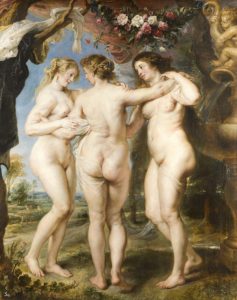
Social Nudity During Early America
This period in history and views on sin and lust in relation with the human body carried into the settling of America. In 1620, the pilgrims traveled on the Mayflower to America. These Pilgrims were also Puritans and brought with them the habit of dressing themselves from head to toe in plain garments. They also refused to bathe. These strict views were more common in America than they were in the majority of Europe.
The body shame and feelings of guilt about being nude were pervasive throughout America. In Europe, the feelings about nudity and sin were mainly restricted to the middle-class. The aristocrats and the lower classes were both prone to take liberties with religious views. As America entered into an age of Puritanism and witch-hunts, the Napoleonic era began in Europe.
Nudity During The Napoleonic Era
With the rise of Napoleon and his empress Josephine, people stopped clinging so tightly to the idea of nudity as sin and nakedness as being entirely for lust. Ladies began to show their shoulders, arms and chests in the evening. Styles went from laced and covered to a more diaphanous neo-classical style. Women began wearing loose, flowing garments again.
Nudity reappeared in the art world, as artists such as Goya were commissioned by Napoleon for statues and paintings. Acceptance of the body was re-established as the norm. This lasted in Europe until the rise of Queen Victoria and the Victorian era. From 1837-1901, Queen Victoria and Prince Albert reigned over England and set the patterns of dress and conduct for that time period.

Nudity During The Victorian Age
In the Victorian era, shame regarding the body and nakedness was such that women began covering all portions of the body that could be seen, with the exception of their faces. Women’s dress consisted of layers of petticoats that prevented the outline of her figure from being shown.
Clothing reached from neck to toe, and shawls were worn to prevent even a glimpse of an outline of her shoulders. Bonnets and lace caps covered the head and gloves were worn upon the hands.
Even while eating dinner, women either wore gloves or finger-less mittens to keep their hands from showing and bringing about feelings of lust. Men wore trousers that were loose and were expected to wear a shirt, vest and coat. Overcoats were frequently layered on top of the clothing.
Hats were also in vogue, as it was shameful to bare the head. Nudity was seen as so immoral and offensive that even bathing suits covered both men and women from head to toe. Women, although fully covered, were still not allowed to be seen in their bathing suits in public.
Beaches were segregated and the use of bathing machines was employed. Bathing machines were wooden structures, covered with canvas, that were taken down into the water and allowed women to enjoy the ocean water. They entered the machines, changed from their street clothing into their bathing suits, and then the machine was rolled down into the water. Women then exited the machine by a series of steps and were allowed to enjoy the ocean as long as they stayed behind the machine and out of sight of others. When they were ready to come back to shore, they entered the machine and raised a small flag which told the beach employees to come bring the machines to shore.
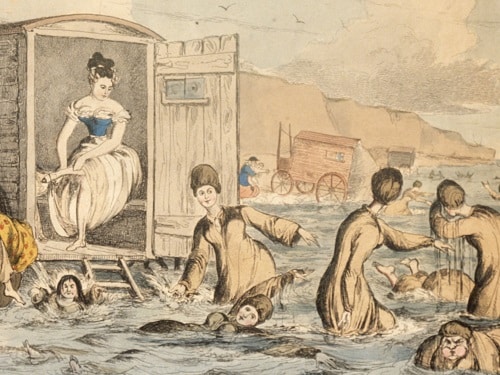
Even everyday language was adapted to suit Victorian standards. The word breast was not allowed, and a chicken breast was simply referred to as white meat. Art suffered at this time as well. The works of Shakespeare were rewritten by another with all references to the body or sexuality removed. Paintings of nudes were forbidden, unless they depicted innocent cherubs. The statues from the Greek and Roman times that had joyfully depicted and celebrated the human body were either fig leafed, loin clothed, or mutilated.
Perhaps the worst travesty of the Victorian Era was the treatment afforded various native cultures by missionaries and Great Britain colonists. Unconcerned about the various hierarchies in Africa and India or the tribal customs, the British of the Victorian Era insisted that the natives conform and wear clothing similar to theirs.
Not only did they force their clothing choices upon these proud people, they also punished them for failure to adhere to their guidelines. Natives were made to feel ashamed and embarrassed for appearing in tribal garments or for appearing nude. Tribal natives, unused to clothing, had no idea how to repair the clothing and it often fell apart on their bodies. Various tribes also did not have the means or knowledge to create new clothing, so they often wore the same clothing over and over again.
They began to no longer bathe for fear of damaging the clothes and thus became unclean. As they gave up bathing, just like the Europeans, they also began to take ill and to die. Disease and death were rampant in Victorian England, and then became rampant among the tribes of Africa and in British-occupied India.
As with any cultural change, there was a backlash against the body shame forced upon people by Victorian England. Thomas Carlyle, an educated man and a proponent of nudism, wrote a dissertation challenging the wearing of clothing. In this discussion he brought up the moral and religious influence of wearing clothes.
He theorized that people would be healthier and happier if they forsook clothing. Benjamin Franklin, on a visit from America, wrote about the health benefits of air bathing. He was often seen swimming nude (skinny dipping) in the Thames. In Switzerland, many noted physicians who were treating the epidemic of tuberculosis that gripped England and Europe wrote of the benefits of sunlight and air on the naked body.
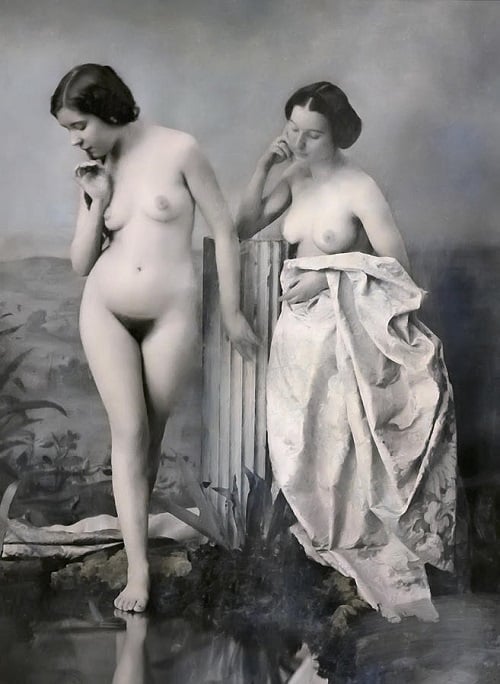
Nudity During The American Renaissance
At the same time that England was gripped by the Victorian Era and bodily shame, America was undergoing a Renaissance. The puritan colonists that had settled America were dead and gone leaving behind their descendants. The fact that America prevailed over Britain in the Revolutionary War gave Americans the idea that they could now focus on free and independent thinking. Nudity again became acceptable.
Some of the greatest Renaissance minds in America included Walt Whitman, Henry David Thoreau, Benjamin Franklin, and President John Quincy Adams. Each of these men not only praised the taking of daily nude “air baths,” but also advocated nude swimming. President Adams could be seen frequently swimming and bathing naked in the Potomac. Walt Whitman wrote that man and nature could only be close if both were naked. He told of how the clothed people in cities were the ones who were dying of disease and illness and that nudity is not a crime or a sin. He said that it is fear and the longing for respectability and power among the classes that is the real sin.
By the same token, Henry David Thoreau stated numerous times in his writings that we must be naked to begin to even comprehend the glory of Nature. He advocated that whatever other people believed in, be it God or Nature or the Sun, or just the spirit of the Earth, man would never be able to comprehend it if he did not practice nudity and rid himself of articles such as clothing that man allowed to come between himself and his other.
Another prominent writer of the time, Mark Twain, mentioned the joy of nudity in his books on Tom Sawyer and Huck Finn, which often had the boys skinny dipping in joy and freedom.
While statesman and noted authors were bringing a positive message about nudity, other forms of art were enjoying a body Renaissance as well. France was enjoying a Renaissance of painting. Henri Matisse and other painters were thumbing their noses at Victorian England by painting works in bright, bold colors, and bringing back the use of nudes in a joyful manner.
Called Fauves or wild beasts, the Fauve painters began to celebrate the body with paintings of nude men and women dancing in joy and abandon. Some of the most famous painters of modern time emerged from the Fauve period including Matisse, Marquet, Manguin, and Rouault. Once again, we see a correlation between the world’s most famous art and the acceptance of nudity.
As England was stuck and grounded in the Victorian Age, the Renaissance experienced in America and France began to spread around Europe. Although, at this point in time, nudity was accepted, it was only practiced by a small number of the population. This acceptance spread to Germany, where it took a firm foothold and paved the way for not only acceptable social / public nudity, but also the nudist movement.
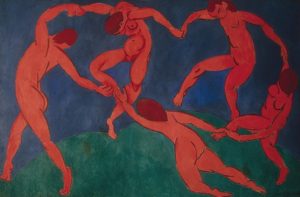
Nudism vs. Naturism and Nudist vs. Naturist
As the twentieth century began, and nudism became more acceptable in America, a movement called naturism began to spread across Europe. Queen Victoria’s reign was at an end and people were tired of being constrained by various layers of clothing. Although France had shed the Victorian image earlier and Switzerland was gaining acclaim for the practice of healthful nudism, the genuine naturism movement began in Germany around the turn of the century.
Jean Baptiste Luc Planchon, a Belgian who had spent time in France, first used the word naturism. Jean Baptiste coined the phrase to refer to a means of improving both life and health. Americans use the words nudism and naturism interchangeably, while in Europe they have profoundly different meanings.
The early naturist movement wasn’t just about nudity. It was a lifestyle and philosophy that generally included respect for the Earth, living in nature, healthy eating, abstinence from alcohol and tobacco, and daily exercises for body and mind.
Today the term “naturism” retains some of the original ideals of the movement. It’s used to promote acceptance, equality and respect for the environment. However nudism and naturism can mean different things to different people, and there are no agreed-upon definitions in the United States. In the most basic sense, both terms can be defined as the practice of being naked in a non-sexual environment, such as the home or within the confines of a nudist community.
Rise of Nudism and The FKK in Germany
In the early 1900’s in Germany, a movement called Freikorperkultur (Free Body Culture) arose. This movement was the first real organization of social nudism. It was a time of the shedding of not only clothes, but also the hidebound values and ways of thinking from Victorian England. In this time period, several noted authors published papers which advocated the removal of clothing as well as an enlightened thinking about the human body. It implored citizens to let go of the idea that the human body is sinful and shameful.
A book entitled The Cult of the Nude, written by noted German sociologist Heinrich Pudor, promoted nudist theories. It must be noted that at this time, the word “cult” had not taken on the negative connotations of today. At that point in history, cult merely referred to a social movement. In his book, Pudor promoted taking part in sports while free of clothing in order to allow the body freedom of movement. He also stated that participating in nudism and combining it with sunlight, fresh air baths, and the philosophy of naturism all combined would contribute to both physical and mental health.
This body acceptance movement spread rapidly throughout Europe into the 1920’s. Sociologists and everyday people were embracing nudism or naturism. Doctors across Europe also united in a Natural Healing Movement and began subscribing air baths, sunbathing, and clothing-free aspects of living in order to treat diseases such as rheumatoid arthritis, tuberculosis, and scrofula.
After a brief disruption during World War I, the movement regained strength and continued to grow across Europe. Special beaches and parks for those practicing nudism and naturism that had closed during the war were reopened. Among these were Freilichtpark, which was originally opened in 1903 by Paul Zimmerman near Hamburg, Germany. Literally translated, Freilichtpark means Free Light Park. Zimmerman stated that by experiencing textile-free living and embracing the world around them, humans were emerging from the dark into the light.
After WWI, around 1920, there were over 200 parks reserved for those who enjoyed practicing nudism. These parks were promoted as a way for man to get back to his roots with nature and to promote good mental and physical health.
Not only were the healthy aspects embraced, but the Europeans, who were worn down and battle weary from four long years of war, embraced these ideas for the Utopian society they portrayed. In the mid part of the 1920’s, around 1926, socialists saw this movement as a way to further their ideals of eliminating the social classes. The movement was also endorsed as way to practice pacifism.
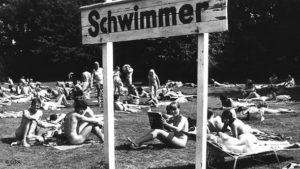
Nudism and the Rise of Hitler and The Nazi Party
From the 1920’s onward, nudism continued to be a growing trend. As Hitler began his rise to power, nudism was first embraced and enjoyed a rise in popularity and prominence. It became extremely popular with Gleichschaltung, which is a term meaning coordination, and was the process used by the Nazi party to establish their control over Europe.
The party celebrated the health benefits and the idea of body acceptance. Hitler also believed in the message of making the body as physically and mentally close to perfection as possible. Therefore he believed that nudism, as well as the ideologies of attaining good health, fit in line with his hopes for a perfect Aryan race.
By 1933 however, Hitler had fallen out of the good graces of the pacifist nudism practitioners and began having Hermann Goring pass laws limiting the mingling of the different sexes. As Europe under Hitler’s regime descended into a quagmire of what Hitler saw as moral and correct, Hitler began to believe that because the nudists practiced pacifism, that the camps and parks were also a place for homosexuals and Marxists.
Hitler and Goring then banned the various parks and camps and passed laws banning the practice of nudism.
Hitler was successful at banning these parks and clubs for exactly one month. But too many of the SS enjoyed partaking of the healthful benefits and continued to practice nudism. Hitler relented and began allowing the practice of nudism again with full support of the state government. However, he did require that all nudist clubs and camps register with the Kraft durch Freude.
Kraft durch Freude translates into “strength through joy” and was the name for the state-controlled leisure organization in Nazi Germany. Its aim was to promote tourism and to make daily activities and fun events accessible to the middle class.
By including nudism, the Nazi Party hoped to overcome the distrust it was experiencing by some. But since it was regulated by the state, this ensured that no Jews, Communists, gypsies or other undesirables could be a part of the nudist movement. Hitler also insisted that all nudist activities were kept confined to rural areas so that the rest of Europe and the world did not look upon Germans as being depraved. Hitler completely missed the point that nudism had nothing to do with sexuality.
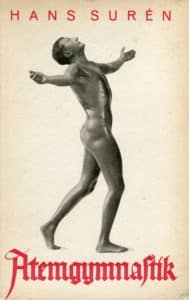
Nudism in Germany after World War II
After World War II, Germany once again enjoyed a nudism revival. In a country so bombarded by war, people longed to return to the ways of pacifism and to again promote a oneness with nature. With Germany split into two factions, nudism was practiced on both sides of the Berlin Wall, although a bit differently. In East Berlin and East Germany, people were allowed to practice nudism, but only at the free beach and parks set aside for nudists.
The former clubs and organizations that naturists had enjoyed prior to the war were banned by the East German government for fear that they would become beds of sedition and subversiveness. West Germany didn’t have these same restrictions and allowed people to return to enjoying their beaches, parks, and various clubs and organizations. As visitors from other countries came to Germany and came face to face with nudism, the idea began to grow and spread across Europe once again.
Areas of the Mediterranean, wishing to lure Germans to the country for tourism, also started embracing the trend and set aside nudist beach areas and parks. Along the Mediterranean coast in France, nude beaches, and resorts began to come to life. In fact, Germans are the most commonly seen visitors in various other countries at their nude beaches and parks.
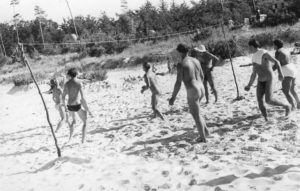
Nudism in France after World War II
The French, much like the Germans in an effort to rid themselves of the horror of war, were only to happy to reopen their nude beaches and naturist venues. Unlike Germany, France was not divided after the war so their clubs and organizations grew without restraint.
In 1944, Albert and Christine Lecocq, two people who were active members of the many nudist clubs, had a major disagreement with clubs about the basic tenets of some of the rules. They broke away and formed their own travel club called Club du Soleil (which means “Club of the Sun”). It became the most popular naturist club in Europe. During the period of 1944 – 1946, they opened over 84 clubs in 84 different European cities. From 1944-1975, they were instrumental in promoting the nudist movement throughout France and Europe.
Their work included founding a magazine devoted to naturism and forming the FFN, or Federation of French Nudists. This eventually evolved into the International Naturist Federation, or the INF. They were also responsible for the opening of the world’s largest naturist holiday center and for getting the FFN and INF recognized as an official youth and tourist movement.
As of the twenty-first century, France has over 200 members clubs, 100 holiday centers, official and unofficial nudist beaches, and many private homes where nudists participate in home nudism along with sunbathing and nude swimming. Nudism continue to be one of the most popular movements in France today.
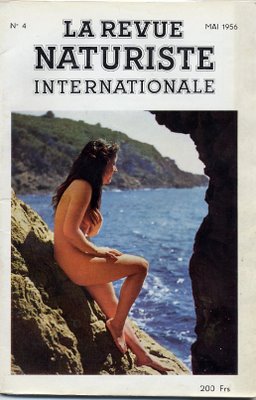
Nudism in Great Britain / England during the 1900’s
While Germany and France were spending the majority of the 1900’s educating themselves and others on the benefits of nudism, Great Britain was a bit slower to embrace the movement. Citizens were coming out of Queen Victoria’s reign and had to adjust their feelings and attitudes towards their bodies. It was a great adjustment to consider that which they had been told was a sin was actually a healthy, normal way of life.
In 1924, an aristocrat under the assumed name of Moonella started a group called the Moonella Group. Members of the aristocracy were carefully vetted for membership. Each club member was given a club name to preserve their anonymity. The club closed in 1926 because the land next to the meeting house had been sold. By 1943, Great Britain had become more comfortable with nudism and had quite a few clubs and organizations. All of these sun clubs joined together to form the British Sun Bathers Association (BSBA).
However, into the early 50’s, many of these clubs fought with each other over what their ideology should be. A large number splintered off and formed their own society, the Federation of British Sun Clubs, in 1953.
In 1961, the BSBA decided at one of their conferences that the term nudist was inappropriate and that the term naturist should be used instead.
By 1962, the feuding had come to an end and nudists had come to an agreement. The factions rejoined and formed British Naturism (BN) in 1964. From 1978-1980, several nude beaches opened in Great Britain as well.
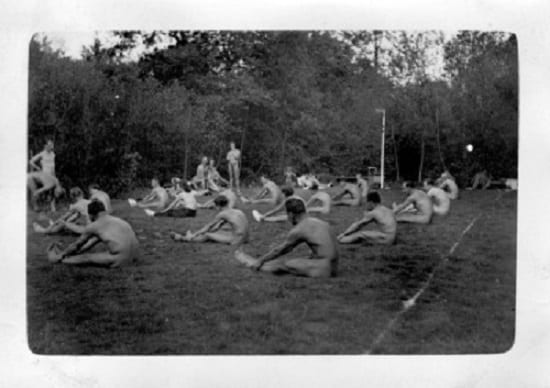
Nudism In America – The Early Days
By 1929 a large number of immigrants had moved to America. Many of these were German immigrants who brought with them their ideas of the nudist lifestyle. They were the first to make Americans see that nudism could exist without being shameful or a sin.
One of these German immigrants was Kurt Barthel, who became known as the founder of American nudism. He had become friendly with other Germans in New York and the U.S. who practiced social nudism, and he allowed himself to be designated as a contact person for Americans who were interested in the movement. Meanwhile another immigrant, Ilsley Boone, must be noted for his work around the same time period. He was a Dutch Reformed Minister in New Jersey who launched a Christian nudist movement.
In 1929, on Labor Day, Barthel led a group of people to a picnic in the Hudson Mountains. What made the outing unique in America was the fact that each member of the party picnicked in the nude, thus creating the first organized nudist recreation.
He organized his attendees into a dues-paying club and named it the American League for Physical Culture (ALPC). In 1930, he moved the group to Spring Valley, New York, and opened the first official nudist club.
By 1931, the club had over 200 members and moved again, this time to Dover, New Jersey. Once he moved to NJ, Barthel became friendly with Ilsley and asked him to take his place as president of ALPC. Ilsley agreed and changed the name of the organization to the American Sunbathing Association. The club continued to grow and struggled through adversity. The club still exists today under the name it finally agreed upon in 1995 which is the American Association for Nude Recreation, or AANR.
Ilsley Boone’s precept was based upon the idea that a nudist is one who goes without clothing unless required by comfort or social norms to wear them; that for many forms of outdoor work and recreation it is better to perform them in the nude than dressed. He advocated a need for a nudist society that would be healthier than one requiring clothes at all times.
The period of 1932 – 1933 saw several other nudist clubs and resorts open around America, some of which are still in operation today, including Rock Lodge Club in Stockholm, New Jersey, Squaw Mountain Ranch in Estacada, Oregon, and Kaniksu Ranch near Spokane, Washington.
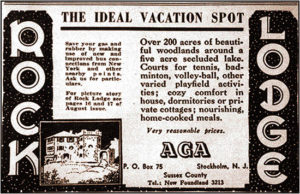
However, in the late 1930’s to 1940’s, nudism was denounced as sinful again by American society. America seemed unable to shed its Puritan background and hangups with the naked body. The worst blow of all was in 1941 when the US Postal Service began enforcing a law from 1873 called the Com-stock Law, which stated that obscene material was banned from traveling through the US Mail Service. Publishers of nudist and naturist magazines stopped sending them to subscribers out of fear of being fined. They attempted to circumvent this law by arguing that their magazines were different from pornography.
In the late 1940’s and early 1950’s, Ilsley Boone argued before the Supreme Court in Washington, D.C., that nudism was neither pornographic nor obscene. He stated that nudism and naturism were not the least sexual in nature and that it was in fact a healthy and natural lifestyle.
He pointed out to the justices that nudists were pacifists who abstained from drugs and alcohol. He pointed out that the majority of the practicing nudists were vegetarians and that they all subscribed to a quiet way of life.
In 1958, the Supreme Court agreed with Boone and ruled that nudist photos and materials were free to travel throughout the USPS. Police raids that had been going on through the late 40’s and 50’s finally began to slow down and then to stop.
The last official raid on a nudist camp took place in 1956 in Michigan. In 1957, the Michigan Supreme Court ruled that nudists had the right to practice nudism in private resorts and parks. So the 1950’s became known as the Golden Age of Nudism.
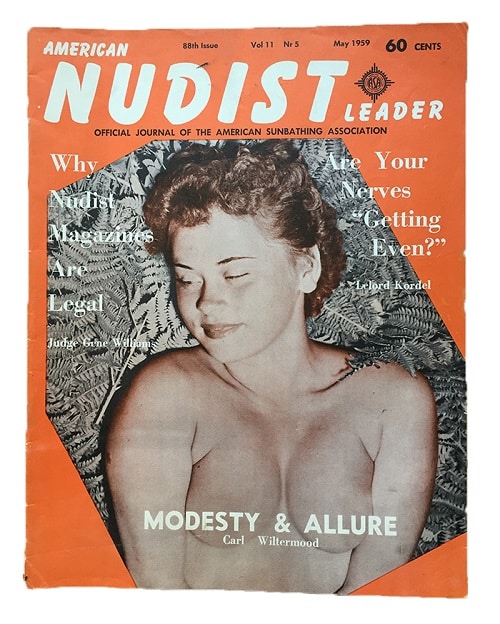
Nudism and Nudity in 1960’s America With Hippie Flower Children
In the 1960’s, nude beaches, especially in hard-to-reach secluded spots, began to grow in popularity. California led the way with the establishment of one of the first nude beaches in San Diego. The culture of America itself began to change in the 1960’s with people growing more accepting of others’ differences.
Socially, culturally, and politically, Americans began to question the intensely strict Puritan values with which they had been indoctrinated. Ilsley Boone’s death in 1960 also paved the way for nudists to become more secular. Boone, until his death, had practiced more of a Christian nudist movement. With the advent of the hippies and flower children tuning in, turning on, and dropping out, nudism became the norm.
Unfortunately, it was a double-edged sword. Nudists had been trying for decades to get the world to see that nudism was not sexual or perverse behavior. The hippies and flower children, while embracing the culture with open arms, were also, at the same time, making a mockery of what nudism represented.
By bringing drugs and sex into the equation, nudists were once again viewed by the mainstream population as sexual deviants. Woodstock and the free love generation didn’t do much to help the movement. Nudism almost lost any chance it had at legitimacy. But the movement would actually find its saving grace in the 1970’s with the sexual revolution, despite how incongruous nudism and sex would seem.
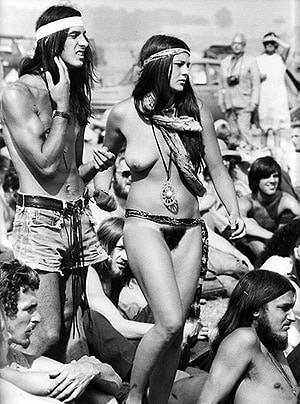
Nudism and Nudists in America during the 1970’s
The sexual revolution of the 1970’s brought nudity and nudism into mainstream America and made it more acceptable. As more people built in-ground swimming pools and hot tubs in their backyards, the idea of being discreetly nude wasn’t so offensive anymore.
At the same time, a “granola” movement took hold, which was about throwing off the drugs and free sex of the 60’s and pursuing a more natural lifestyle. Americans started wearing organic clothing, and it became more socially acceptable for women to go without a bra. This was all in line with a cultural “back to nature” trend that was growing and a desire for peace after the war in Vietnam as well.
With its ideology of harmonious and clean living, the nudist movement in the 1970’s found more followers and sympathizers, including some of those who would not have dreamed of accepting it in the fifties.
Another by-product of the 1970’s and the sexual revolution was the fact that simple nudity was making its way into the mainstream media and pop culture. In 1972, Playboy published its first photo of a nude woman without parts of her body being airbrushed out. That, along with movies such as Midnight Cowboy, made nudity appear more natural to the average American. The generation that was coming of age during this time period saw nothing embarrassing or lewd about nudity.
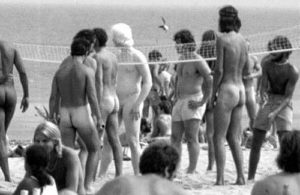
Nudism and Nudists in California and the Free Beach Movement
It was the younger generations of Americans, for whom nudity had become more normal, that renewed and expanded the naturist movement. Whereas social nudity that was practiced in America until that time period had either been in the enclosed enclaves of private resorts or camps, a group of young Americans in California began visiting beaches in the nude.
They would set up their beach chairs and other activities in full view of clothed persons. If there were any complaints, they would never argue, but instead would pick up their belongings and move further down the beach until they came to a more secluded area where there were either fewer people, or people who would not complain.
After a few years of this, the particular sections of the beaches where they had set up became generally known as nude beaches.
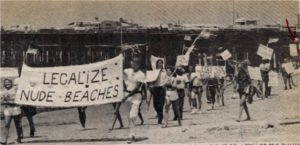
Club Nudists vs. Free Beach Nudists
At this point in history came another round of discord within the movement. The American nudists who had fought so long and hard with Ilsley Boone were dismayed by the overt sensationalism that went along with the nudists who were fighting for their civil rights to appear nude on beaches. They refused to acknowledge the “free beaches” people and refused to offer their support at their trials and rallies.
This anti-beach group insisted that it was because they were afraid people would no longer join their camps and resorts and pay the associated fees needed to keep them running. The ASA camps said they had fought long and hard to have their camps considered respectable. They argued that their stance on nudism was that while it was normal and healthy, it was not a view that they felt should be forced and pushed on others.
The ASA argued that by going to trial and fighting for the right to be nude in the open on federal land such as beaches and parks, they were giving the nudist movement a bad name. Ironically, as many of the Free Beaches people aged, they began to tire of the fight and actually joined the ASA and their clubs.
Nudism and Nude Recreation in America
The 1970’s also saw the expansion of nudist activities and venues. While nudists had been vacationing together at their private parks, tourism boards and travel agencies began courting their business. Windjammer opened their Barefoot Cruises which they marketed towards the nudist population as did Club Med, with a resort called Club Orient that they opened for nudists in the Caribbean.
The state of Texas saw the opening of a travel agency exclusively for nudists named “Bare Necessities.” This agency booked tours and cruises that catered to their nudist clientele.
Nudism vs. Pornography in the 1980’s in America
In the 1980’s the extreme right began attacking nudism. By 1984, when the Meese Report on Pornography was published, opponents to nudism took the opportunity to attempt to have nudity labeled as an “adult” activity. This meant that while they could not get it banned, they could try to have it regulated like other adult-oriented businesses, such as strip clubs.
This meant nudism would be subject to new zoning laws and regulations, and they could also prohibit couples with children from practicing nudism as a family.
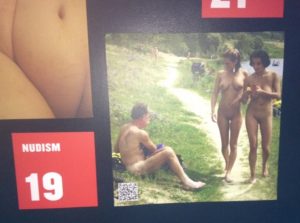
Rocky Times For Nudism in America as Nudists Fight Back and Lee Baxandall Creates the Naturist Society
In 1985, a man named Lee Baxandall, one of the original members of the Free Beach Society, took his local grassroots firm of beach volunteers and print publications and formed The Naturist Society (TNS). In doing so he launched a wide campaign to get nudism back to its naturist roots.
By using the term naturist again, Baxandall hoped that America would associate it with the branches from Europe that promoted family-friendly activities and philosophy. He also hoped to move away from the negative connotations of the word nudist.
Each year, in an effort to promote the positive aspects of naturism, TNS would hold gatherings for naturists and the public alike. Clothing would be optional, and being nude not required. The goal of the gatherings was to promote the activities that TNS participates in, both social and recreational, to middle America.
In addition, public opinion polls were held to see how Americans felt about public nudism on designated lands. The good news for the naturist movement is that the general public has become much more tolerant. TNS has been very careful to promote the fact that naturism is a family-friendly, non-sexual, way of living.
Baxandall himself commissioned a series of videos designed to promote naturism as a family-friendly activity. Along with TNS, he also founded the Naturist Action Committee, a watch dog group designed to be an early warning system against groups who wanted to legislate the naturist movement out of existence.
He was the first of any of the nudists or naturists to employ a lobbyist whose job was to get The Naturist Society’s agenda promoted in Washington to state senators and representatives.
Baxandall married his longtime girlfriend in 1992. In 1995 he was diagnosed with Parkinson’s Disease. He continued to fight for the rights of naturists until 2002, when the disease forced him to retire as an activist. He lived the rest of his life as a naturist full of joy until he succumbed to Parkinson’s in 2008 and passed away.
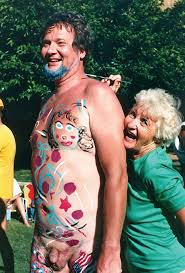
New Nudism and Nudists in the 21st Century
Things are looking brighter for the nudist movement as of today. Mainstream America has become more comfortable with nudity, thanks to television and the media. Senior citizen groups are actually selling calendars of their members in the nude for fundraising efforts.
With the vast array of travel opportunities and retreats scheduled by tourism and travel agencies, nudists are finding it easier than ever to be themselves while living the life they could only dream of a few decades prior. Thanks to the Internet, nudist groups can reach a lot more people and educate them about nudism as a wholesome, healthy lifestyle rather than one based on immorality and depravity.
Exercise classes such as naked yoga and pilates classes have sprung up around the country and are growing in popularity. Some of the old rustic nudist camps are still around, but clothing-optional or nudist upscale resorts have entered the scene as well. Forbes magazine reported that the nudist recreation industry brings in over $800,000 per year.
Over 50 years ago, bans against human contact (hugging, kissing, holding hands) were put into place in nudist camps for fear that naked people touching would be considered pornographic. The majority of these bans have been lifted, and couples are free to hold hands as they stroll along beaches. Americans have come to realize that the unrestrained sexuality and public couplings never came to pass.
It does appear that Americans are becoming more comfortable with the idea of social nudity. The fear that existed among Americans of sin and depravity have actually been replaced with worries over body image. America still has a long way to go before enjoying the freedom that European nudists experience, but the gap between the two is lessening every day.

This Comprehensive guide to the history of nudism, nudists and nudity was published by Felicity’s Blog.
Sources:
“Body Acceptance: A Brief History of Social Nudity.” Lupin Lodge — A Clothing-Optional Getaway For All Seasons. Web. 09 Sept. 2010. http://www.lupinlodge.org
Carr-Gomm, Phillip. “A Brief History of Nakedness”. Reaktion, 2010. Print
Dans Nudism Website. Web. 09 Sept. 2010. http://www.dans-nudism.com/history.html.
Ganns, H. “CATHOLIC ENCYCLOPEDIA: Martin Luther.” NEW ADVENT: Home. Web. 09 Sept. 2010. http://www.newadvent.org/cathen/09438b.htm.
Goodson, Aileen. “Nudity in Ancient to Modern Cultures–Aileen Goodson.” Primitivism. Web. 09 Sept. 2010. http://www.primitivism.com/nudity.htm.
“Heroes of Clothes Freedom : Lee Baxandall.” http://www.i-naked.info.html.
Holy Bible, NIV, Tyndale Publishers. 2007.
Hooker, Richard. “Reformation: John Calvin.” Washington State University – Pullman, Washington. 1999. Web. 09 Sept. 2010. http://www.wsu.edu/~dee/REFORM/CALVIN.HTM.
Patterson, Jennifer. “From Nakedness To Naturism: The Democratization Of A Clothing-Optional Lifestyle” | FR2DAY.com – The Lifestyle Magazine That Covers the South of France & Monaco.” July-Aug 2009.
Ross, Chad. “Naked Germany: health, race and the nation.” Print
Storey, Mark. “Social Nudity, Sexual Attraction, and Respect”- Nude & Natural magazine, 24.3 Spring 2005.
The American Association for Nude Recreation
This article was last published in September 2017 and has been edited for clarity and accuracy.



